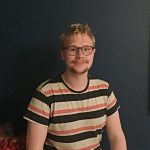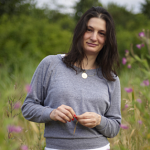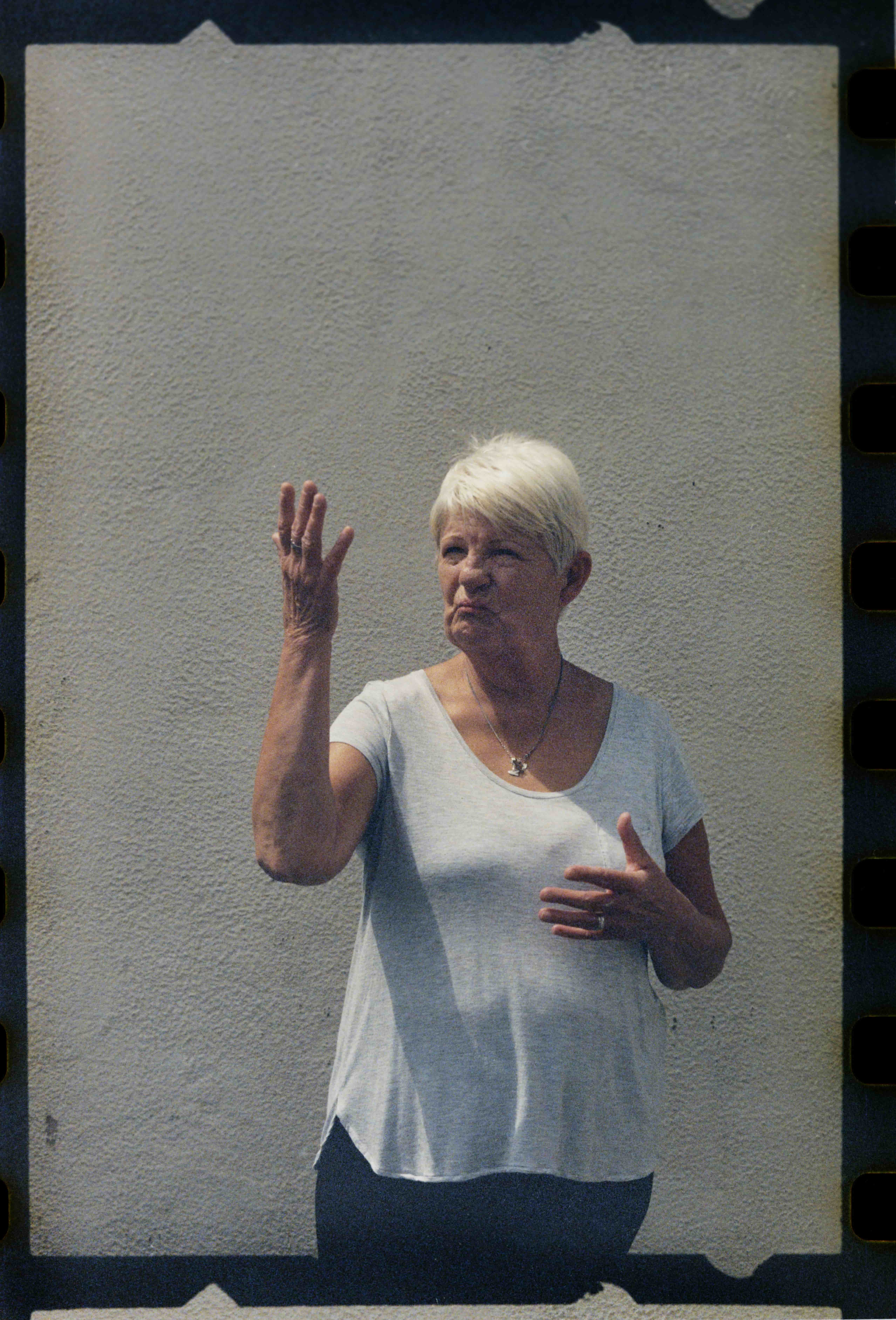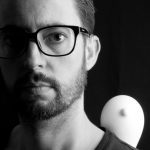
The experience of TDS
Aftter their residences across the UK, Rubbena Aurangzeb-Tariq, Christopher Sacre, Louise Stern and Ruaridh Lever-Hogg have prepared BSL videos explaining their experience of The Translated Deaf Self.
Ruaridh Lever-Hogg
 Ruaridh was an intern shadowing Christopher Sacre at Deaf Action, Edinburgh:
Ruaridh was an intern shadowing Christopher Sacre at Deaf Action, Edinburgh:
‘As an artist my perspective is about timelines and responses to an interpreter and the responses to the visual information delivered. If there is information missing within the interpretation, then the message is not clear and I’m not sure if I understand the full meaning of the information being given to me. I equate this to different colour schemes. When deaf people developed work in the workshops they picked colours that they felt connected to. If they are angry they will pick colours that show their disconnection or anger, such as the colour red.
There are companies that use black and red and that can be negative. They could use blue as a natural and calming colour, or positive colours such as yellow or green. This is based on 4 sections of the colour wheel and the full colour palate’
TDS Experience and BSL video
“Deaf people have their own identities and they respond and engage in different ways. When they are given information from an interpreter, it could be a written message or spoken word, the interpreter hears/sees that source message and then re-packages it and delivers a translation to a Deaf person. Do they feel engaged with the source message? Also, there are a variety of different responses from deaf people, most of them have time to build a rapport with an interpreter, to feel connected with an interpreter, make sure that their sign languages match. We have different deaf communities around the UK, with different regional dialects of sign language. As an example, if you have two different cities, local interpreters working with their local deaf community. If an interpreter visits from another city, how will they be able to understand and connect with the local deaf community. They might not have an understanding of that city’s BSL dialect. If they use a local interpreter, they feel that will have more of a connection with that interpreter.
If you have a successful session with an interpreter and they have given you a good translation it’s very important for the community to have accurate translations and its very important for the deaf person to feel connected to that interpreter. Hearing people can have direct conversations with each other, but as a deaf person we have to go through a third person, an interpreter, to have a conversation with a hearing person. That interpreter needs to ensure that presented with 100% of the information or as a minimum 80% of that information and when they respond and want to be confident that a minimum of 80% of what someone saying is translated to the hearing person.
As an artist my perspective is about timelines and responses to an interpreter and the responses to the visual information delivered. If there is information missing within the interpretation, then the message is not clear and uncertain if understand the full meaning of the information being given to me. I equate this to different colour schemes. There are companies that use black and red and that can be negative, they could use blue as a natural and calming colour, or positive colours such as yellow or green. This is based on 4 sections of the colour wheel and the full colour palate.
I think about interpreters in terms of four different colours, so for me if I visualise the colour red, that’s quite negative, it might feel irregular with that interpreter, not comfortable with that interpreter, don’t feel connected with that interpreter and then the message isn’t clear. It’s like to visualise a red X a warning in the head, everything is very blurry…can’t even see their face very clearly, everything is a red blur.
The second painting is blue. This is connected to eye contact. If you have eye contact, then that’s fine, but if you don’t have proper eye contact you will miss information and that actually doesn’t feel like a human interaction and the interpreter is not taking the time to explain things to you. Yellow means the translation is clearer, but there are still some elements affecting the translation, the hand shapes aren’t perfect so still haven’t received the full message yet. Obviously, it takes time when an interpreter meets a new deaf person, they need time to go through the process of building a rapport, it doesn’t happen quickly, you need time to understand each other, so yellow is still slightly blurry. The last colour represents a very clear interpretation, the figure and sign language is very clear. Receive 100% of the message have a connection with the interpreter and this experience is represented by the colour green. When someone work with that interpreter and feel connected to them, trust them, feel comfortable with them, at the opposite end of the spectrum a bad interpreter or an interpreter and don’t work well with is represented by the colour red and that is how I present them.
What I see though the research and my own artistic practise, it’s not easy for me as my ideas can get influenced by other people work and I want to keep developing as an artist. The work I am presenting for exhibition is about the process of translation and not forgetting how the information is presented to me, I take it on board and then change it and what happens when some information is missing.
It’s a challenge for me, it’s about how I understand communication. I’m happy with the workshop and what I’ve learnt and using colour schemes and feeling engaged with the timeline and what I’ve learnt about that and about different times and deaf people; if they meet a new interpreter they need time to develop a connection. I’ve created four images that visually represent the issues of interpreted communication; either a very, very blurred communication all the way to an image of clear information and a connection with that translation as well as the interpreter. It’s about knowing that the information given to that interpreter is the same as the information that you’re receiving and that the information is clear.”
Louise Stern
 Louise’s residency took place at Royal Association for the Deaf People (RAD) in Essex.
Louise’s residency took place at Royal Association for the Deaf People (RAD) in Essex.
‘Born in California to a 4th generation deaf family, I saw in art and literature a way to investigate and liberate. In my work, I use the written word and visual images to examine language, emotion, and communication, filtered through deafness.
For Translating the Deaf Self, I am honoured to work with the people at the Romford Deaf Club. I photographed them talking about their lives and their experiences of using an interpreter, and asked them to write a few words taken from what they told me. I knew that writing is often uncomfortable for deaf people, but wanted the finished pieces to look at different forms of language. I have then put together the photographs, the scraps of writing, and pieces of paper taken from the British Legion where the Club meets to make a portrait of communication and environment’
TDS Experience and BSL video
“Hi – I’m Louise Stern. I wanted to tell you a bit about this project – Translating the Deaf Self – and what I’ve worked on in relation to this project. I’ve felt quite honoured to be working with the Romford Deaf Club. My work has been connected to language and communication, and different ways people communicate, including writing back and forth, signing, and speaking. I know many deaf people who always feel that writing is difficult because of a lack of confidence. Sign uses the body… emotion, rhythm all come within the body. For this project, I really wanted to show this, what can be expressed through the body. Does writing seem to convey the same emotion? Does it seem different? Fluid? Awkward? A combination? Communication about life, and also about translation, because that’s what this project is about. I wanted to have a look at that. I’ve photographed different people signing, telling me about their lives and their experiences of using interpreters. I’ve also asked them to write down a few words of what they have communicated via sign. The photos, the writing, plus some paper from their environment will be put together into collages. I hope they will be portraits of communication.They will be about how people express themselves. It has been a beautiful experience… My work has evolved over time, and this has been a natural but important experience. It represents a new phase. It has been beautiful working with this community – a group of deaf people, my community, my roots. It has been a pleasure getting to know each person and looking at what they have to say. I hope you enjoy viewing the work. Thank you.”
Artwork selection

Christopher Sacre
 Christopher’s residency took place at Deaf Action in Edinburgh. He started with a blank canvas prior to the residency but had given it a lot of thought and had an idea in mind. Over the two weeks members of the deaf community and the general public took part in ‘drop-in’ sessions where Christopher was able to engage with the participants through discussion, drawings and sculpture with the use of various materials. The participants focused on what ‘Translating the Deaf Self’ meant to them and specifically their feelings, emotions, moods, shape forms and the colours that represent these.
Christopher’s residency took place at Deaf Action in Edinburgh. He started with a blank canvas prior to the residency but had given it a lot of thought and had an idea in mind. Over the two weeks members of the deaf community and the general public took part in ‘drop-in’ sessions where Christopher was able to engage with the participants through discussion, drawings and sculpture with the use of various materials. The participants focused on what ‘Translating the Deaf Self’ meant to them and specifically their feelings, emotions, moods, shape forms and the colours that represent these.
Christopher gained an insight into each individual’s experiences and as the residency progressed each participant formed a piece of the jigsaw that would result in a series of artworks. It was a challenge to compile so many different accounts but he felt the project was worth exploring further and a great opportunity to look in depth at what being ‘translated’ really means to deaf people.
TDS Experience and BSL video
“When I was involved in the ‘Translating the Deaf Self’ project it was the first time I had participated in an Arts Residency and this residency was with Deaf Action in Edinburgh. The residency lasted for two weeks, I did not know what to expect but had an idea in the back of my mind. However, I wanted to hold onto this idea and wait until I had engaged with the participants through discussion, drawings, sculpture and the use of various materials. It was extremely interesting to learn about each individual’s experience. I was also able to identify similar works of art they produced and with the original idea I had I was able to combine the two. One challenge I had was having so many different stories and being able to bring them all together to represent everyone involved when they had been translated.
I feel it was a great opportunity being involved in the project, involving deaf culture but the difference is when translating the deaf self your looking in detail at the individual and how they are translated such as a voiceover or interpretation does it match the individual. I feel when I began creating the final piece it was a challenge to create a piece of art that’s represents everyone involved.”
Rubbena Aurangzeb-Tariq
 Rubbena was in residency at Deafplus in Whitechapel, East London. Rubbena Aurangzeb-Tariq is a British born artist of Pakistani origin from London. Rubbena held workshop sessions which were attended by local members of the Deaf community. The majority of those who attended were refugees and immigrants who have experienced huge challenges adapting to a different culture, language and lifestyle with very limited access to resources and education. They shared their feelings of frustration in having to adopt new languages but struggling to understand and be understood.
Rubbena was in residency at Deafplus in Whitechapel, East London. Rubbena Aurangzeb-Tariq is a British born artist of Pakistani origin from London. Rubbena held workshop sessions which were attended by local members of the Deaf community. The majority of those who attended were refugees and immigrants who have experienced huge challenges adapting to a different culture, language and lifestyle with very limited access to resources and education. They shared their feelings of frustration in having to adopt new languages but struggling to understand and be understood.
Rubbena gathered that they had a collective experience of struggle and frustration at not being accurately ‘mirrored’ in the process of BSL translation, often leaving them with feelings of doubt about what was being translated and communicated- having to constantly intensively focus on trying to be clearly translated, but encountering barriers because of limited fluency in BSL and English.
‘These contemporary abstract artworks portray the structural challenges of the struggle to be heard and understood, mirroring the dynamic of three people in the translation process-deaf-person, hearing person, interpreter – and the constant shifting of a sense of puzzlement and doubt as interaction flows. Colours in the work reflect the shifting emotions of the translative ‘journey’’.
